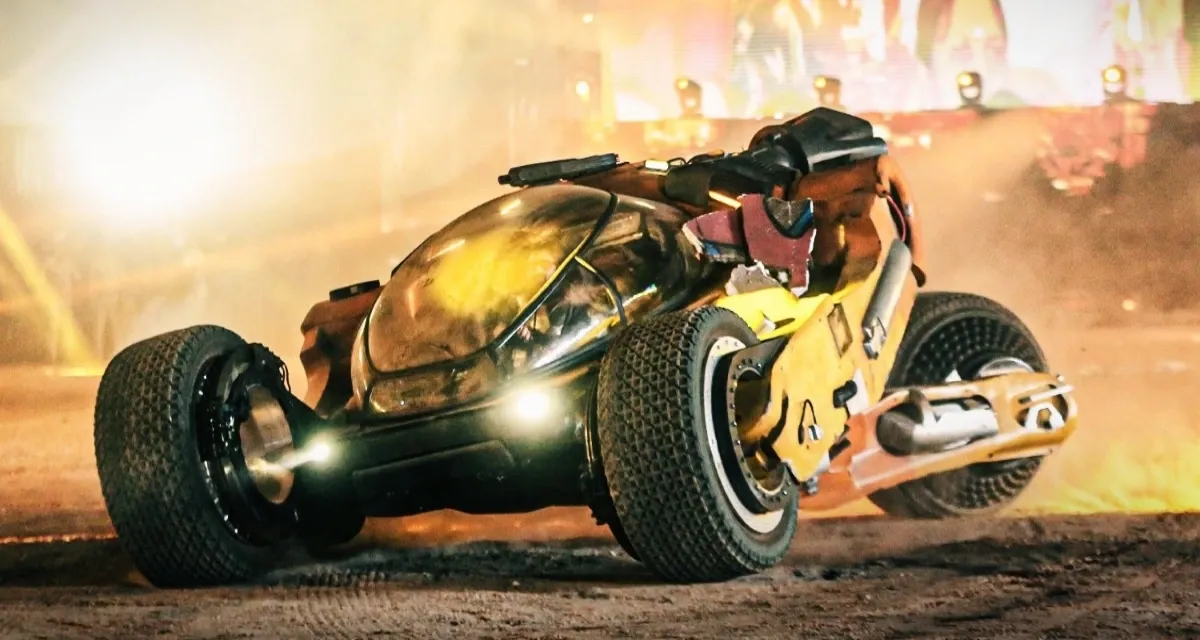
Delve into the Automotive Dystopian world by Driving the Bujji movie car from Kalki 2898 AD

Delve into the Automotive Dystopian world by Driving the Bujji movie car from Kalki 2898 AD
Who doesn’t want to experience the marvels of automotive engineering? From Flying cars to now Bujji movie cars, futuristic cars have been keeping the gearheads enthusiastic. The Bujji movie car, designed for the film "Kalki 2898 AD," is truly an extraordinary experience. On a scorching 47-degree Celsius day, you can find yourself at the CoASTT track in Coimbatore, surrounded by nothing but the heat and a brand-new racetrack, ready to test this monstrous machine.
The Bujji car is a promotional vehicle for the movie and is like nothing I’ve ever seen. It’s an enormous machine, over six meters long, three meters wide, and two meters tall. It features two hubless wheels in the front and one at the rear that can move on both vertical and horizontal axes. The all-glass canopy closes over a minimalist cabin, making the car look futuristic and intimidating. Standing next to its 34.5-inch rims, I felt completely dwarfed.
This unique vehicle was the brainchild of the movie's director, Naga Ashwin, who, despite having computer-generated imagery at his disposal, decided to build a real-life version of the car. With contributions from Mahindra & Mahindra’s product development team and Jayem Automotives from Coimbatore, the car was brought to life.
It is an adventure in and of itself getting into the car. It is a one-story hike up to the bare cabin. The air conditioning was a wonderful break from the stifling heat, even with the incomplete interior. With a lever, the foldaway steering wheel is secured in position. The canopy closed over my head once I was inside, and I moved using another lever. Thanks to electric motors, the six-ton car travels with ease despite its weight.
It is strange to drive Bujji around the CoASTT track. The car feels unstoppable because of its enormous power and distinctive design. Interestingly, the 47kWh battery located in the back of the car is not the prison cell shown in the movie. Visitors are told to steer onto the track by one of the engineers. The automobile handled like a giant truck despite having just one rear wheel, passing around wide curves and cones with ease and smoothness.
The Bujji car is powered by twin air-cooled Kirloskar induction motors, producing a combined power of 94kW and an astounding 9,800Nm of torque. It has a Transformers-like appearance because of its painted exterior, which is designed to look like it's created out of leftover metal. The front wheels are mounted on hollow hubs with performance suspension racing struts and each has two brake calipers. The wheels are made of foreign aluminum alloy.
The three-ton rear axle is supported by specially designed coil springs and dampers in the rear suspension. This automobile has amazing engineering. The rubber for the rims was specially made by CEAT, giving the tires a distinctive tread pattern.
The steering system on the car is a marvel of contemporary engineering. A lever is used to lock the foldaway design into place. Fluid pressure is transferred from the electro-hydraulic pump to the gerotor-type orbital hydraulic motor via an electro-hydraulic system that is coupled to a hydraulic orbital steering control valve. This feels like technology from 2898 AD because it is further tailored to the rear swing arm.
At first, this exact vehicle was supposed to be used in the film. However, the filmmakers were forced to use computer-generated imagery and props for the film because of the two-year construction period. Still, they chose to finish the vehicle for promotion, showcasing their dedication to bringing a futuristic vision to life.
In Conclusion, Driving the Bujji movie car will be an adventure. Its impressive size, distinctive design, and cutting-edge technology set it apart from any vehicle one has ever had the pleasure of driving. This car, designed for a dystopian future, brought a piece of the movie "Kalki 2898 AD" into reality. While the film relied on CGI, the real-life Bujji serves as a testament to human ingenuity and creativity, merging the worlds of cinema and automotive engineering spectacularly.
Also Read: